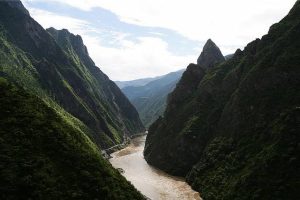More than 70 big and medium-sized hydropower plants displacing Tibetans in Kardze Prefecture

More than 70 large and medium-sized hydropower plants have been built and are under construction in Kardze (Ch: Ganzi) Tibetan Autonomous Prefecture, Sichuan Province, reported the official Sichuan Daily on 25 September.
The spurt in dam building has been triggered by China’s 13th Five-Year Plan (2016-2020) that calls for large-scale expansion of hydropower projects in the ecologically fragile Tibetan areas in Sichuan, Yunnan and Qinghai.
The report indicated that the hydropower plants are concentrated in and around the Nyagchu (Ch: Yalong) River, Drichu (Ch: Jinsha) River, Gyarong Ngulchu (Ch: Dadu) River) and their tributaries. It added that the estimated hydropower reserves in the prefecture were about 50 million kilowatts, out of which 41.3 million kilowatts could be exploited.
The dam building spree has predictably caused the displacement of local Tibetans who are now forced to live in resettlement camps and rely on government handouts. Although the exact number of the relocated population remains unknown, the report noted that a number of resettlement camps have been built in various counties such as Dartsedo (Ch: Kangding), Chaksam (Ch: Luding), Rongdrag (Ch: Danba), and Gyesur (Ch: Jiulong). The prefecture authorities have so far spent 9.1 billion yuan on relocating local residents.
The report further claimed that the Ganzi Prefecture Hydropower Migrants Unit, under the guidance of the Ganzi Party committee and the government as well as the Provincial Poverty Alleviation and Development Bureau, has been “serving the [hydropower] migrants, promoting project construction, developing the reservoir area, and ensuring social stability.”
Since the dam building began, provincial and national highways totalling more than 230 kilometres in the prefecture have been repaired to support the infrastructural development necessary for the massive hydropower expansion plan, although the report maintained it was done to ease travel for local people.
Local authorities claimed that since the beginning of the 13th FYP, the prefectural authorities have spent 8.33 million yuan in providing “technical” and “practical” training skills to displaced people including “employment skills transfer training”, “ cooking and chef training” as well as providing skilled manpower in the development of rural tourism for “hydropower migrants” in the Dadu River Basin and the Yalong River Basin. There are also claims that displaced people have been provided other financial support and jobs in the hydropower enterprises.
While the actual condition of the displaced people cannot be independently assessed, the fact that Chinese authorities have gone ahead with its plan to build a series of dams the ecologically-fragile Tibetan plateau is deeply concerning. China had pledged to reduce greenhouse gas emissions through ‘clean energy’ sources for about 20 percent of its primary energy consumption by 2030. Clearly, the pledge is being fulfilled, exploiting the hydropower resources of the Tibetan plateau, the source of Asia’s major rivers, and ignoring the serious environmental risks caused by big dam projects.


